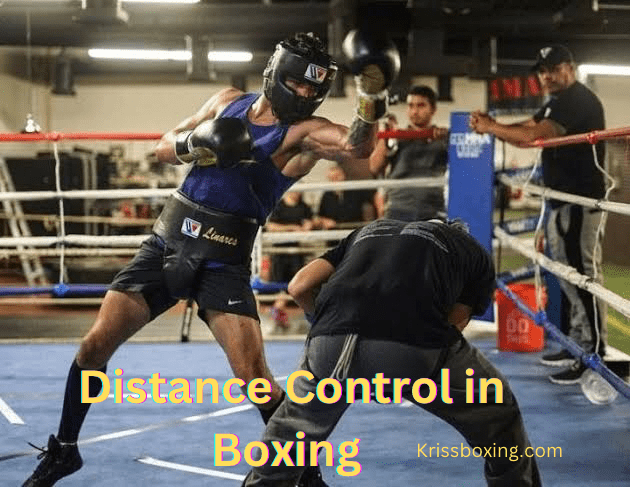Distance management is a key factor that differentiates the level of two boxers, and it is considered to be one of the key factors in the ring.
It gives the boxer the ability to decide when and where to strike and avoid the opponent’s correct strikes at the same time.
In this article, we focus on the elements of distance control, methods for applying distance, and how to include this idea in your drills and matches.
The Importance of Distance Control in Boxing
Distance control is not a matter of taking the enemy at an arms-length away: it’s about occupying a range where you can strike and are not struck.
Appropriate management of distance allows for the saving of energy, avoidance of damage, and exploitation of one’s strengths at the same time as the revelation of the opponent’s blind spots.
Benefits of Distance Control
- Defensive Advantage: Thus, the distance control will make it complex for your opponent to deliver powerful punches to you. It decreases the amount of damage you receive and enables you to endure more confrontations.
- Offensive Opportunities: Distance management makes certain you are most of the time in the right and appropriate place to create a proper assault. In general, distance is a brilliant tool that helps you decide where you want to stand and whether you want to participate in the battle or not.
- Pace and Rhythm Control: Distance control allows you to set out different rhythms of the battle. It allowed Fong or the opponent to decide the pace at which the latter comfortable or uncomfortable for the opponent would have to engage in the fight.
Major Concepts in Distance Regulation
- Range Awareness: It is also crucial to know the long, mid, and close ranges, as for how one operates within them. This range has specific techniques and strategies that may be applied as illustrated in the case of ASD.
- Footwork: It is elementary that effective footwork is one of the most critical facets of distance regulation since it is the starting point of influence. Fluently and efficiently you can move inside the range and at the same time, you will be able to avoid your opponent’s strikes.
- Feints and Head Movement: Feints are not advisable to be used together with head movement as they throw off the distance and increase the chances of delivering punches by the opponent.
Strategies of Keeping Appropriate Distances
Distance control is a skill that involves knowledge, planning, and most of all repetition.
Below are some advanced strategies that would facilitate your effort to stay on top of your opponent during a fight.
Footwork Techniques
- Lateral Movement: By side-to-side movement rather than backward motion, one can keep the required distance with the bonus of not being vulnerable to an opponent’s rush. This movement helps you stay off the main road where the enemies are and forms positions from where you can launch counterattacks.
- Pivoting: Swing used in cricket can be explained as pivoting where one has to move the lead foot to change the direction of usage of the body. This can make you dodge a punch and position you to set up your shot from a different angle.
- In-and-Out Movement: This includes throwing punches and successfully getting close to the opponent before landing them and then backing off for safety’s sake. Because it allows you to constantly disrupt your opponent and stops them from securing their attacks.
Hand and Head Techniques
- Jabs and Probes: It is also advisable to use jabs and probing punches to measure the distance and make the opponent keep off your defense range. These punches can break your opponent’s rhythm and leave him/her open to bigger punches.
- Head Movement: Closures of the head from side to side while at the same time regulating distance can cause a lot of trouble for the opponent. Dodging, stinging, sliding, moving around with an opponent, and rolling under punches are standard tactics to be able to keep distance and counterattack.
- Feints: Feints may also be applied to deceive the opponent as to one’s plans and confuse them concerning certain distances. In this case, you can establish blind spots and deny your opponent the boots to effectively counter your actions.
Defensive Strategies
- Using the Lead Hand: The lead hand is useful in estimating distance, and also helps to keep the opponent at arm’s length. Pawing and probing are some of the extended lead hand techniques that ensure that you keep the opponent at arm’s length while setting up punches.
- Clinching: Clinch is a particularly great option to use when an opponent decides to close the distance with the intent of striking as it eliminates his assaults and reverses the range. This technique will enable you to dictate the timing to deliver your shots and at the same time gain sufficient room to move around.
- Angle Changes: Switching stances also renders you the possibility of creating distance and likely you’ll be able to land a few punches on your opponent. Turning enables you to reduce the chances of your opponent landing successful punches while positioning you nicely for an attack on the opponent.
Frequently Asked Question
Why is distance control important in boxing?
Distance control is critical because it helps a boxer set the pace, avoid hard hits, and open the opportunities to launch an attack. When one manages to box at the correct distance, he can throw effective punches at the same time avoid his opponent's punches.
What can I do to enhance my distance control when boxing?
Work on your distance with footwork drills that include lateral and in-and-out movements to move into position to get the right distance and then use jabs and feints to check the distance. Sparring and practicing with the coach can also contribute to improving the skills of distance management.
What are pitfalls that need to be avoided in controlling distance?
Some of the common errors may include rigid body movements in which one moves backward parallel to the wall instead of sideways, failure to use jab and feints to assess the distance, and failure to incorporate head movement in their engagements. Such mistakes deprive you of the opportunity to keep a proper distance from your opponent so that you will not be subjected to his punches.
How does footwork impact distance control?
Footwork is important for distance management because it enables a boxer to avoid closing the gap or moving closer to the opponent’s range. Lateral movement, movements around a center point, and in-and-out movements slide the attacker from side to side and guard while providing a vision for angles of attack.
Is it possible to use distance control as a defense and as an attack?
Distance control has to be employed not only in defense but also in attack. It also has a defensive use which assists in the avoidance of punches and equally, the reduction of their impact. Offensively, it guarantees that one is always in the right position to strike and take advantage of the rigid and unchanging errors of the other team.
Conclusion
Distance control in boxing is technically, tactically, and quantitatively built successively as a result of distinct practice.
The noted factors of range awareness and the use of proper footwork and advanced techniques show how you can improve your chances of winning a bout.


